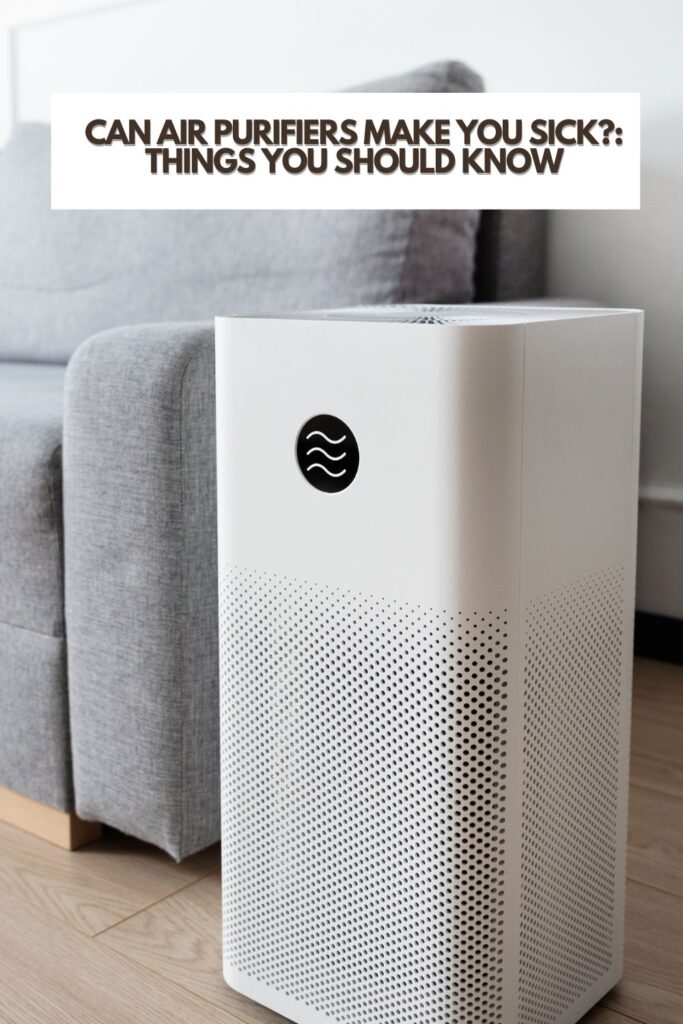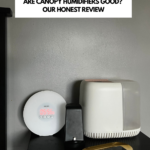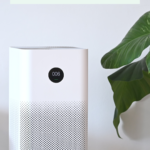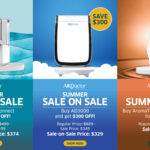Can air purifiers make you sick? Air purifiers have become increasingly popular in recent years as people become more conscious of indoor air quality and its impact on health. While these devices claim to remove pollutants from the air and promote a healthier living environment, there is some debate on whether they can actually cause harm to individuals exposed to them.
In this article, we will explore the potential ways air purifiers and air filters could contribute to health problems and discuss the efficiency of these devices in maintaining good indoor air quality.
Air purifiers work by using filters and other methods to trap particles, allergens, and pollutants in the air. They are commonly used in homes, offices, and other enclosed spaces to reduce contaminants and improve overall air quality. However, some studies and anecdotal evidence suggest that certain types of air purifiers may have negative effects on health.
FTC DISCLOSURE: Some of the links in this post are affiliate links. If you click on them and make a purchase, I will receive a small finder’s fee on the sale. This does not increase your price in any way shape or form. Using these links help support the continuation of this website. All opinions are my own. Thank you in advance.
For instance, some devices release small amounts of ozone, a potentially harmful substance, during their normal operation.
YOU MIGHT LIKE TO READ:
We Tried This $500 Air Purifier So You Won’t Have To
It is essential to weigh the benefits and risks of using air purifiers to make an informed decision. With proper understanding, care, and maintenance, air purifiers can be effective tools in promoting a cleaner and healthier living environment.
Key Takeaways
- Air purifiers can be effective in improving indoor air quality but may pose potential health risks.
- Some air purifiers may release ozone as a byproduct, which can be harmful in certain situations.
- Choosing a certified air purifier and following proper care and maintenance guidelines can mitigate risks.
Air Purifiers: Basics and Functionality
Air purifiers are devices designed to remove harmful particles from the air, improving indoor air quality. They use a variety of filters and methods to achieve this goal. In this section, we will discuss the basics and functionality of air purifiers, including the types of filters used, their efficiency, and their impact on air quality.
The primary component of air purifiers is the filter, which can come in different types. The most common and effective type is the HEPA (High Efficiency Particulate Air) filter. HEPA filters are designed to capture particles as small as 0.3 microns, removing up to 99.97% of airborne contaminants from the air. This includes common allergens such as pollen, dust mites, and pet dander, as well as smaller particulates like smoke, bacteria, and viruses.
In addition to the HEPA filter, many air purifiers also incorporate other filtration technologies, such as activated carbon for removing odors and chemical pollutants, pre-filters for capturing larger particles and prolonging the life of the HEPA filter, and UV-C light for killing bacteria and viruses. Some air purifiers use ionizers to release charged particles that attach to and neutralize airborne contaminants, making them easier to capture by the filter.
One way to evaluate the performance of an air purifier is by its Clean Air Delivery Rate (CADR). CADR is a measurement developed by the Association of Home Appliance Manufacturers (AHAM), which indicates the volume of filtered air that an air purifier can deliver in a specific amount of time.
Higher CADR values mean the air purifier is more effective at filtering the air in a given space. When selecting an air purifier, it is essential to choose one with a suitable CADR for the room size in which it will be used.
Potential Health Risks
While air purifiers can be beneficial in removing allergens and contaminants from the air, there are potential health risks associated with their use. We want to provide you with clear and accurate information to help you make informed decisions.
Ozone Generation and Health Problems: Some air purifiers, particularly ionic air purifiers and ozone generators, can produce ozone as a byproduct. Ozone is a lung irritant and can lead to health problems such as sore throat, coughing, and inflammation. The levels of ozone produced by these devices can vary, but it is essential to be aware of the risks associated with ozone exposure.
Misconceptions About Air Purifiers: It’s crucial to understand that air purifiers are not a complete solution for improving indoor air quality. They can help reduce specific pollutants and allergens in the air, but they cannot eliminate all contaminants. Radon, for example, is a harmful gas that an air purifier cannot remove. Therefore, it is essential to address other factors contributing to poor air quality, such as proper ventilation, to avoid potential health risks.
Dirty Filter Issues: Over time, filters in air purifiers can become clogged with pollutants, reducing their effectiveness and potentially releasing contaminants back into the air. Regular filter maintenance is crucial. Failure to do so can result in a dirty filter, which can not only make the air purifier less effective, but also potentially harmful to your health.
Air Purifiers and Respiratory Conditions
Air purifiers can play a significant role in managing respiratory conditions like asthma and allergies. By maintaining clean air in our living spaces, we can potentially reduce allergens and pathogens responsible for triggering respiratory symptoms.
One of the key benefits of air purifiers is their ability to filter out airborne allergens like dust, pollen, pet dander, mold, bacteria, and viruses. These contaminants can worsen respiratory problems, making it challenging for individuals with asthma or allergies to breathe comfortably.
Air purifiers work by drawing in polluted air, capturing allergens and pathogens in their filters, and releasing clean air back into the room. This process can be beneficial for people with respiratory conditions, as it can help reduce triggers like wheezing, runny noses, and other allergy symptoms.
However, it is essential to choose the right air purifier for our needs. For instance, a device with a HEPA (High-Efficiency Particulate Air) filter can effectively remove particles as small as 0.3 microns, which includes common allergens such as dust mites, pollen, and pet dander. Additionally, some air purifiers have activated carbon filters, which can help neutralize odors and remove volatile organic compounds (VOCs) that may irritate the respiratory system.
While air purifiers can be beneficial in managing respiratory conditions, it is worth noting that they are not a complete solution. Proper cleaning practices, such as vacuuming and dusting, and removing sources of allergens like mold and pet dander, should be combined with the use of air purifiers to maintain an optimal indoor environment.
Use of Air Purifiers in Specific Conditions
In certain situations, air purifiers can be beneficial for improving indoor air quality and reducing exposure to harmful contaminants. We will briefly discuss various conditions where air purifiers might be helpful, and how their use can impact overall health.
In areas with heavy smoke and pollution, such as industrial zones or urban centers, air purifiers can help remove dangerous particulates and gaseous pollutants. Using HEPA filters and activated carbon filters, air purifiers can capture particulate matter and harmful gases, reducing our exposure to these pollutants.
During the COVID-19 pandemic, portable air purifiers with HEPA filters have been recommended to help reduce the risk of airborne transmission. They can capture respiratory droplets and aerosols effectively, although they cannot replace other preventive measures such as wearing masks and maintaining social distance.
Wildfires can cause a significant increase in outdoor air pollution, leading to poor indoor air quality as well. Air purifiers with HEPA and activated carbon filters can decrease the levels of particulate matter and hazardous VOCs produced by wildfires, promoting a healthier indoor environment.
For homes with pets, air purifiers can help remove pet dander, hair, and associated odors, reducing allergy symptoms for sensitive individuals. Some air purifiers also feature specialized filters designed specifically for pet-related air contaminants.
When it comes to indoor gas leaks or strong odors, certain air purifiers with activated carbon filters can adsorb harmful gases and unpleasant smells, providing relief and contributing to a more comfortable living space. However, it is crucial to address the root cause of the gas leaks and odors to prevent harm.
For environments compromised by polluted air from sources like vehicle emissions, construction dust, or allergens, air purifiers can provide a layer of protection. By filtering out harmful particles and allergens, they aim to create a healthier indoor atmosphere.
Lastly, in spaces where tobacco or cigarette smoke is present, air purifiers equipped with HEPA and activated carbon filters can reduce the harmful effects of secondhand smoke and clear the air of lingering odors.
Understanding Air Purifier Ratings and Certifications
When researching air purifiers, you may come across various ratings and certifications that help determine the effectiveness of the device in filtering out pollutants. We want to provide you with an understanding of these ratings and certifications, so you can make an informed decision.
One of the key ratings to look for is the Clean Air Delivery Rate (CADR). This rating is a measure of an air purifier’s ability to remove different types of particles, such as dust, pollen, and smoke. A higher CADR indicates a more efficient air purifier, capable of cleansing air more quickly.
HEPA air purifiers are another standard you’ll encounter. High-Efficiency Particulate Air (HEPA) filters remove at least 99.97% of particles 0.3 micrometers in size. These purifiers provide excellent filtration, capturing even the smallest pollutants like bacteria, mold spores, and pet dander.
When it comes to filter performance, Minimum Efficiency Reporting Values (MERV) rating system plays a significant role. MERV ratings range from 1 to 20, with higher numbers representing better filtration capabilities. For residential use, a MERV rating of 8 to 13 is typically sufficient, whereas commercial or medical settings may require a rating of 14 or above.
The Environmental Protection Agency (EPA) also provides certifications for air purifiers in order to ensure their safety and effectiveness. The ENERGY STAR certification, for example, ensures that the air purifier not only provides efficient performance but also consumes less energy, resulting in cost savings and a smaller environmental footprint.
Care and Maintenance of Air Purifiers
As air purifier owners, we understand that regular care and maintenance are crucial to ensuring our devices remain effective in removing pollutants. By cleaning and maintaining our air purifiers, we can prolong their lifespan and prevent them from making us sick.
Firstly, it’s essential to clean and replace filters regularly. Air purifiers rely on filters to capture dust particles, mold spores, and other airborne contaminants. Depending on the type and usage of air purifier, we recommend checking filters every 3 to 6 months and replacing them as needed. Some air purifiers come with washable filters, making it easy to clean and reuse them.
We also suggest keeping our air purifiers clean by wiping down their exterior surfaces with a damp cloth regularly. This practice helps prevent dust and grime buildup, which could otherwise impact the device’s performance.
Another important aspect of air purifier maintenance is positioning. We should place our air purifiers in areas with limited obstructions, away from walls, and plants. Doing this ensures proper airflow and prevents mold spores or other pollutants from accumulating around the device.
In some instances, using plants in conjunction with an air purifier can be beneficial. Certain plants are known for their air-purifying qualities and can help remove pollutants. However, it’s essential to care for our plants properly, as overwatering or neglect can lead to mold growth, which would defeat the purpose of using an air purifier.
By taking these straightforward steps, we can ensure that our air purifiers remain efficient in providing us with clean and healthy air, free of harmful pollutants.
Misconceptions Regarding Air Purifiers
There are several misconceptions surrounding air purifiers that cause people to be concerned about their potential health effects. We will address some of these misconceptions to provide a clearer understanding of air purifiers and their benefits.
One common misconception is that air purifiers produce dangerous levels of ozone. It’s important to differentiate between ozone generators, which intentionally produce ozone for air purification, and HEPA or activated carbon air purifiers, which do not produce ozone.
Ozone generators have been found to produce high levels of ozone, which can lead to respiratory issues. However, HEPA and activated carbon air purifiers operate differently and do not emit harmful levels of ozone.
Another misunderstanding is related to the use of negative ions in air purifiers. Some people assume that negative ions can be harmful since they involve a transfer of electricity. However, these ions are naturally occurring and are not harmful at the levels produced by air purifiers. In fact, negative ions can have a positive impact on indoor air quality by helping to neutralize airborne particles and remove them from the air we breathe.
A further misconception is that air purifiers can introduce harmful substances like lead, carbon monoxide, or formaldehyde into the air. This assumption is not accurate. Air purifiers are meant to remove contaminants; they do not generate or introduce new pollutants.
In the case of activated carbon filters, for example, they primarily serve to adsorb volatile organic compounds and other gaseous pollutants in the air, like formaldehyde and benzene, rather than create new contaminants. This is a great way to reduce the chances of health conditions and allergic reactions.
Lastly, some people believe that air purifiers can negatively affect our body’s natural positioning and balance. This belief is unfounded, as air purifiers do not directly impact our physical positioning or body’s functioning. Instead, they work to improve indoor air quality, leading to an overall healthier environment in which to live and work.
In summary, it is essential to distinguish between various types of air purifiers and to clarify misconceptions to make informed decisions about their use. While some concerns arise from the use of ozone generators, air purifiers utilizing HEPA or activated carbon filters do not present similar risks. By understanding these misconceptions, we can confidently use air purifiers to improve the quality of the air in our homes and offices.














